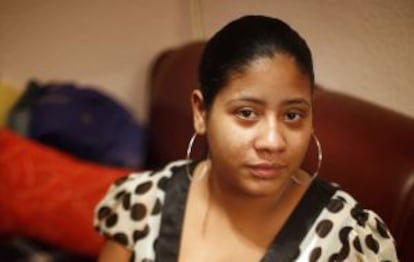"The crime that killed my mother helped to reduce racism in Spain"
Lucrecia Pérez Matos, from the Dominican Republic was victim of the most notorious racist murder in recent Spanish history

She remembers her mother's "sweetness," but all that remains are "a few photos." Her mother was Lucrecia Pérez Matos, the immigrant from the Dominican Republic who was the victim of the most notorious racist murder in recent Spanish history. Kenia Carvajal Pérez tells her story hesitantly, timidly. She is 26, with a baby on the way. A few months ago she came to Spain for the first time, thanks to a "family regrouping" visa, and is now living in Madrid, the city where an off-duty civil guard, Luis Merino Pérez, accompanied by three minors, killed her mother.
The crime that left her an orphan, she says, "has helped to reduce racism in Spain."
"I was only six when they murdered my mother," says Kenia. Lucrecia Pérez, 33, left her Dominican village, Vicente Noble, when the organizer of her journey told her the time had come. It was a roundabout journey, with many stops, to circumvent the controls that, in the early 1990s, were beginning to be imposed on immigration. In Spain she found a job as a maid, in a family with three children. The job lasted 20 days. "I fired her because she was just no use at all. She didn't know what a faucet was, or a bathtub, or an elevator," said Pérez's employer, who said she regretted her death. "But she did clean well," added the daughter.
Lucrecia, ill and jobless after a costly journey, took refuge in an abandoned nightclub, called Four Roses, in Aravaca, a wealthy suburb. Many other immigrants were squatting in the same building, leading to protests from neighbors, police harassment and racist handbills calling for "direct action."
It was there that she was killed on November 13, 1992, when four black-clad men burst into the building and fired into a group of the immigrants. Kenia and her father learned of the killing later that day.
Xenophobic reaction against immigrants in Spain had never gone so far as murder, and the public was outraged. In answer to demands from various groups, the Spanish government granted Kenia a pension. But the payments, which were supposed to continue until she was 18, were stopped seven years later, when she was 13, with no explanation.
The trial of the killers, who belonged to extreme-right groups and received lengthy sentences, led to a compensation payment of around 120,000 euros. "I don't remember how much it was. I never dealt with it," she explains. "It helped to build a house, buy some land and let me study. I went to university, and I have a year to go in accounting."
The girl, brought up by her father, who worked as a laborer in construction and agriculture, married a neighbor at the age of 17. Her husband emigrated to Spain, while she stayed at her studies until April, when, having obtained a visa, she first set foot in the country where her mother was killed. Kenia has visited the site of the abandoned nightclub, which was demolished. A small monument to Lucrecia Pérez stands nearby. Though "only God knows why he does things," Kenia thinks her mother's death served as a vaccine against xenophobia. "For things to change, sometimes somebody has to die," she says. "But I lost my mother."
Tu suscripción se está usando en otro dispositivo
¿Quieres añadir otro usuario a tu suscripción?
Si continúas leyendo en este dispositivo, no se podrá leer en el otro.
FlechaTu suscripción se está usando en otro dispositivo y solo puedes acceder a EL PAÍS desde un dispositivo a la vez.
Si quieres compartir tu cuenta, cambia tu suscripción a la modalidad Premium, así podrás añadir otro usuario. Cada uno accederá con su propia cuenta de email, lo que os permitirá personalizar vuestra experiencia en EL PAÍS.
¿Tienes una suscripción de empresa? Accede aquí para contratar más cuentas.
En el caso de no saber quién está usando tu cuenta, te recomendamos cambiar tu contraseña aquí.
Si decides continuar compartiendo tu cuenta, este mensaje se mostrará en tu dispositivo y en el de la otra persona que está usando tu cuenta de forma indefinida, afectando a tu experiencia de lectura. Puedes consultar aquí los términos y condiciones de la suscripción digital.
Últimas noticias
From Andorra to Gibraltar, a black market for Ozempic exploits its success: ‘They’re the most sought-after products in the world’
Magnets in their heads: How some animals guide themselves using the Earth’s magnetic field
From Hungary’s Orbán to Chile’s Kast: How Trump helps turbo charge the far right
The brief rise and retreat of Generation Z in Mexico
Most viewed
- Why we lost the habit of sleeping in two segments and how that changed our sense of time
- Trump’s obsession with putting his name on everything is unprecedented in the United States
- Charles Dubouloz, mountaineering star, retires at 36 with a farewell tour inspired by Walter Bonatti
- Venezuela faces its most tense Christmas yet
- The Florida Keys tourist paradise is besieged by immigration agents: ‘We’ve never seen anything like this’








































